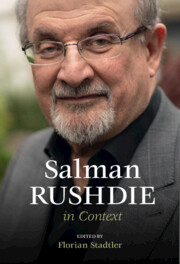Book contents
- Salman Rushdie in Context
- Salman Rushdie in Context
- Copyright page
- Dedication
- Contents
- Contributors
- Acknowledgements
- Introduction
- Part I Life
- Part II Literary and Creative Contexts
- Chapter 5 Salman Rushdie and the Urdu Tradition
- Chapter 6 Art-Historical Magic Realism and Rushdie’s Twenty-First-Century Politics
- Chapter 7 Salman Rushdie and Intertextuality
- Chapter 8 Salman Rushdie and Visual Art and Culture
- Chapter 9 Rushdie, Sound, and the Auditory Imagination
- Part III Historical and Cultural Contexts
- Part IV Critical Theoretical Contexts
- Part V Reception, Criticism, and Adaptation
- Works by Salman Rushdie
- Select Bibliography
- Index
Chapter 5 - Salman Rushdie and the Urdu Tradition
from Part II - Literary and Creative Contexts
Published online by Cambridge University Press: 23 March 2023
- Salman Rushdie in Context
- Salman Rushdie in Context
- Copyright page
- Dedication
- Contents
- Contributors
- Acknowledgements
- Introduction
- Part I Life
- Part II Literary and Creative Contexts
- Chapter 5 Salman Rushdie and the Urdu Tradition
- Chapter 6 Art-Historical Magic Realism and Rushdie’s Twenty-First-Century Politics
- Chapter 7 Salman Rushdie and Intertextuality
- Chapter 8 Salman Rushdie and Visual Art and Culture
- Chapter 9 Rushdie, Sound, and the Auditory Imagination
- Part III Historical and Cultural Contexts
- Part IV Critical Theoretical Contexts
- Part V Reception, Criticism, and Adaptation
- Works by Salman Rushdie
- Select Bibliography
- Index
Summary
Salman Rushdie’s work has been linked to innovations in form in relation to the genre of the novel. What he has been most credited for is the bringing of subcontinental storytelling traditions into the Indian novel in English. This chapter traces these origins with reference to prose and poetry contexts of Urdu and Hindustani, so important to Shame, The Satanic Verses, The Enchantress of Florence, and Haroun and the Sea of Stories. Moreover, the chapter considers his engagement with poet Faiz Ahmed Faiz, a family friend and a much admired poet. Rushdie’s position in relation to Urdu opens up stylistic innovations on his part as well as an indebtedness to the storytellers and writers who have engaged with the tradition/modernity debate before him. This chapter thus considers Rushdie as part of a wider contextual framework of ideas of the secular and sacred on the Indian subcontinent, often neglected in discussions of his work.
- Type
- Chapter
- Information
- Salman Rushdie in Context , pp. 67 - 77Publisher: Cambridge University PressPrint publication year: 2023

